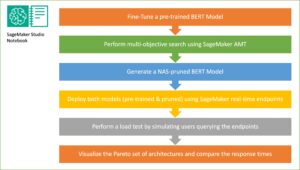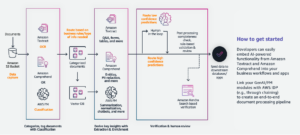Amazon Translate is a neural machine translation service that delivers fast, high-quality, affordable, and customizable language translation. Amazon Translate now supports formality customization. This feature allows you to customize the level of formality in your translation output. At the time of writing, the formality customization feature is available for six target languages: French, German, Hindi, Italian, Japanese, and Spanish. You can customize the formality of your translated output to suit your communication needs.
You have three options to control the level of formality in the output:
- Default – No control over formality by letting the neural machine translation operate with no influence
- Formal – Useful in the insurance and healthcare industry, where you may prefer a more formal translation
- Informal – Useful for customers in gaming and social media who prefer an informal translation
Formality customization is available in real-time translation operations in commercial AWS Regions where Amazon Translate is available. In this post, we walk you through how to use the formality customization feature and get a customized translated output securely.
Solution overview
To get formal or informal words and phrases in your translation output, you can toggle the formality button under the additional settings on the Amazon Translate console when you run the translations through real-time requests. The following sections describe using formality customization via the Amazon Translate console, AWS Command Line Interface (AWS CLI), or the Amazon Translate SDK (Python Boto3).
Amazon Translate console
To demonstrate the formality customization with real-time translation, we use the sample text “Good morning, how are you doing today? ” in English:
- On the Amazon Translate console, choose English (en) for Source language.
- Choose Spanish (es) for Target language.
- Enter the quoted text in the Source language text field.
- In the Additional settings section, enable Formality, and select Informal on the drop-down menu.
The translated output is “Buenos días, ¿cómo te va hoy? ” which is casual way of speaking in Spanish.
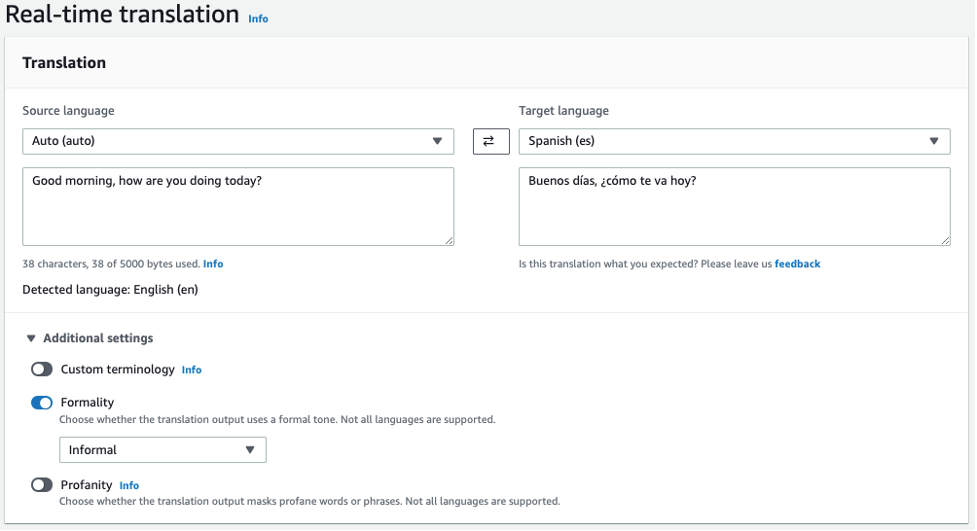
- Now, select Formal on the drop-down Formality menu.
The translated output changes to “Buenos días, ¿cómo le va hoy? ” which is a more formal way of speaking in Spanish.
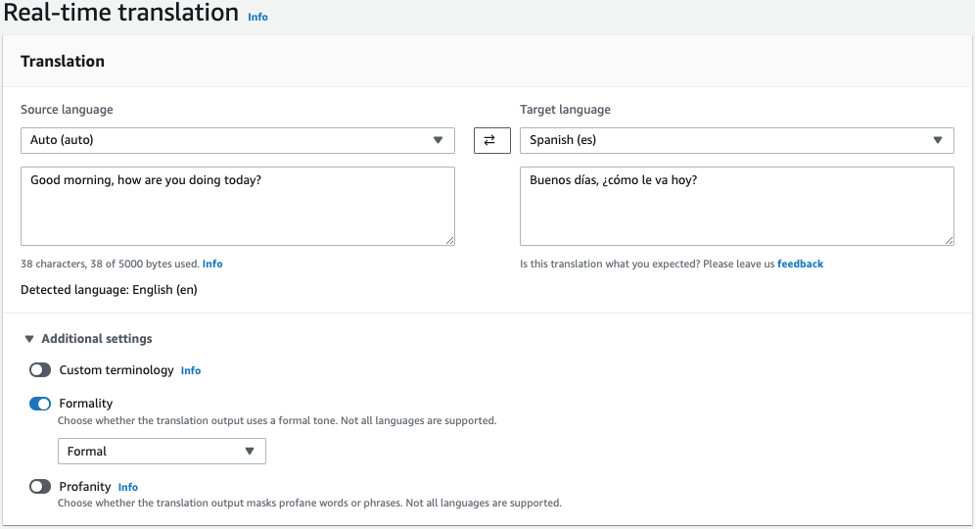
You can follow the preceding steps to change the target language to other supported languages and note the difference between the informal and formal translations. Let’s try some more sample text.
In the following examples, we translate “So what do you think? ” from English to German. The first screenshot shows an informal translation.
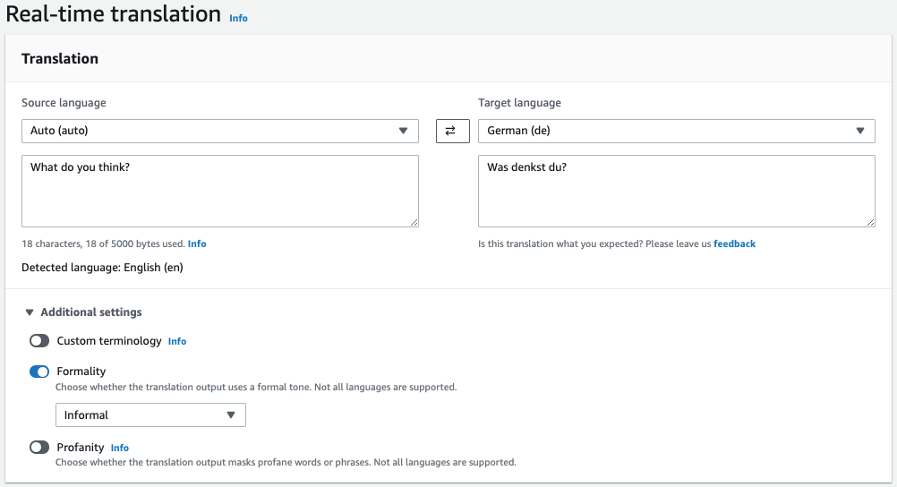
The following screenshot shows the formal translation. 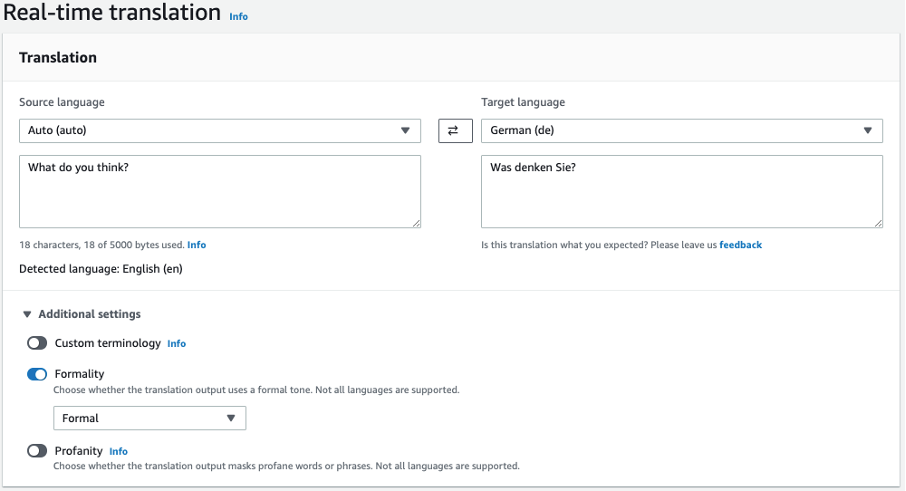
In another example, we translate “Can I help you? ” from English to Japanese. The first screenshot shows an informal translation.
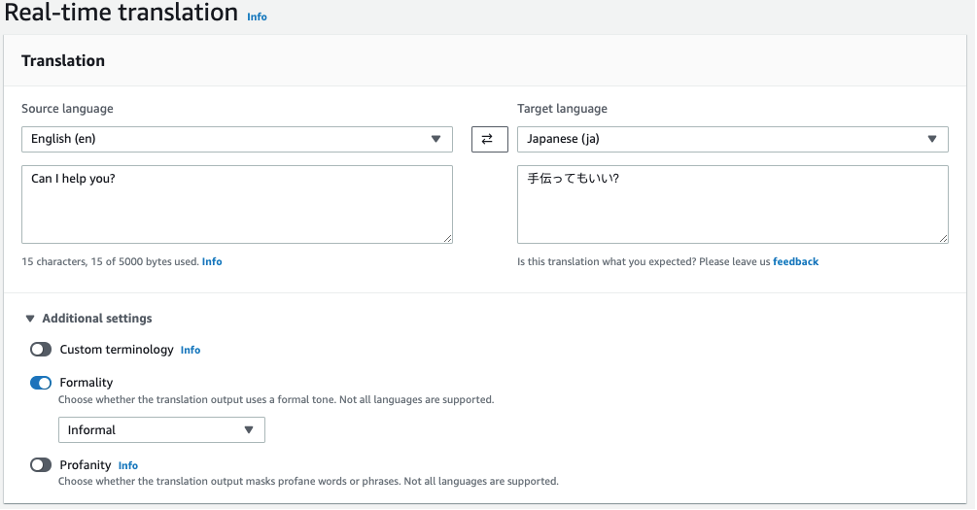
The following screenshot shows the formal translation.
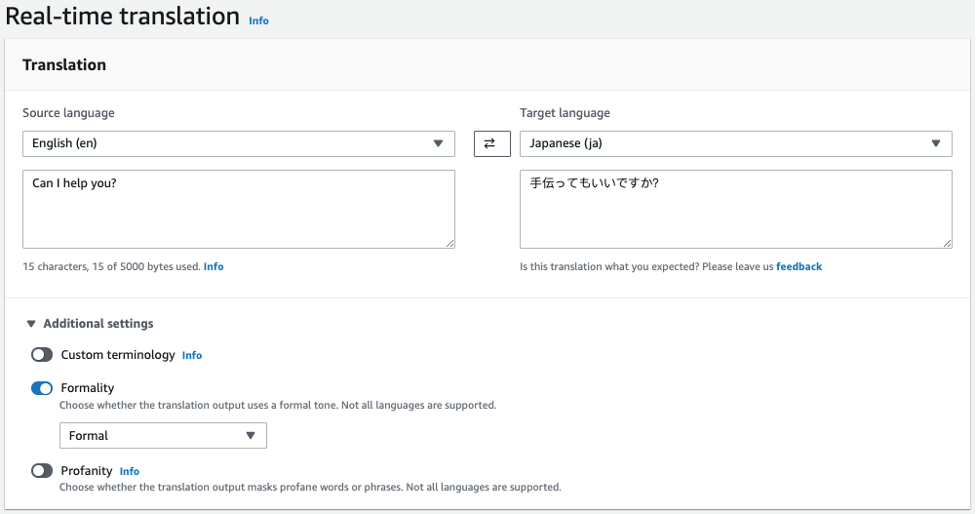
AWS CLI
The translate-text AWS CLI command with --settings Formality=FORMAL | INFORMAL translates words and phrases in your translated text appropriately.
The following AWS CLI commands are formatted for Unix, Linux, and macOS. For Windows, replace the backslash () Unix continuation character at the end of each line with a caret (^).
In the following code, we translate “How are you? ” from English to Hindi, using the FORMAL setting:
aws translate translate-text --text "How are you?" --source-language-code "en" --target-language-code "hi" --settings Formality=FORMALYou get a response like the following snippet:
{ "TranslatedText": "आप कैसे हो?", "SourceLanguageCode": "en", "TargetLanguageCode": "hi", "AppliedSettings": { "Formality": "FORMAL" }
}The following code translates the same text into informal Hindi:
aws translate translate-text --text "How are you?" --source-language-code "en" --target-language-code "hi" --settings Formality=INFORMALYou get a response like the following snippet:
{ "TranslatedText": "तुम कैसे हो?", "SourceLanguageCode": "en", "TargetLanguageCode": "hi", "AppliedSettings": { "Formality": "INFORMAL" }
}Amazon Translate SDK (Python Boto3)
The following Python Boto3 code uses the real-time translation call with both formality settings to translate “How are you? ” from English to Hindi.
import boto3
import json translate = boto3.client(service_name='translate', region_name='us-west-2') result = translate.translate_text(Text="How are you?", SourceLanguageCode="en", TargetLanguageCode="hi", Settings={"Formality": "INFORMAL"})
print('TranslatedText: ' + result.get('TranslatedText'))
print('SourceLanguageCode: ' + result.get('SourceLanguageCode'))
print('TargetLanguageCode: ' + result.get('TargetLanguageCode'))
print('AppliedSettings: ' + json.dumps(result.get('AppliedSettings'))) print('') result = translate.translate_text(Text="How are you?", SourceLanguageCode="en", TargetLanguageCode="hi", Settings={"Formality":"FORMAL"})
print('TranslatedText: ' + result.get('TranslatedText'))
print('SourceLanguageCode: ' + result.get('SourceLanguageCode'))
print('TargetLanguageCode: ' + result.get('TargetLanguageCode'))
print('AppliedSettings: ' + json.dumps(result.get('AppliedSettings')))
Conclusion
You can use the formality customization feature in Amazon Translate to control the level of formality in machine translated text to meet your application context and business requirements. You can customize your translations using Amazon Translate in multiple ways, including custom terminology, profanity masking, and active custom translation.
About the Authors
 Siva Rajamani is a Boston-based Enterprise Solutions Architect at AWS. He enjoys working closely with customers and supporting their digital transformation and AWS adoption journey. His core areas of focus are serverless, application integration, and security. Outside of work, he enjoys outdoors activities and watching documentaries.
Siva Rajamani is a Boston-based Enterprise Solutions Architect at AWS. He enjoys working closely with customers and supporting their digital transformation and AWS adoption journey. His core areas of focus are serverless, application integration, and security. Outside of work, he enjoys outdoors activities and watching documentaries.
 Sudhanshu Malhotra is a Boston-based Enterprise Solutions Architect for AWS. He’s a technology enthusiast who enjoys helping customers find innovative solutions to complex business challenges. His core areas of focus are DevOps, machine learning, and security. When he’s not working with customers on their journey to the cloud, he enjoys reading, hiking, and exploring new cuisines.
Sudhanshu Malhotra is a Boston-based Enterprise Solutions Architect for AWS. He’s a technology enthusiast who enjoys helping customers find innovative solutions to complex business challenges. His core areas of focus are DevOps, machine learning, and security. When he’s not working with customers on their journey to the cloud, he enjoys reading, hiking, and exploring new cuisines.
 Watson G. Srivathsan is the Sr. Product Manager for Amazon Translate, AWS’s natural language processing service. On weekends you will find him exploring the outdoors in the Pacific Northwest.
Watson G. Srivathsan is the Sr. Product Manager for Amazon Translate, AWS’s natural language processing service. On weekends you will find him exploring the outdoors in the Pacific Northwest.
- '
- "
- 100
- activities
- Additional
- Adoption
- Amazon
- Another
- Application
- available
- AWS
- Black
- border
- business
- call
- challenges
- change
- Cloud
- code
- commercial
- Communication
- complex
- Console
- control
- Core
- Customers
- digital
- Digital Transformation
- documentaries
- English
- Enterprise
- example
- FAST
- Feature
- First
- Focus
- follow
- following
- French
- gaming
- healthcare
- healthcare industry
- help
- How
- How To
- HTTPS
- Including
- industry
- innovative
- insurance
- integration
- language
- Languages
- learning
- Level
- Line
- linux
- machine
- machine learning
- macos
- manager
- Media
- Operations
- Options
- Other
- outdoors
- Pacific
- phrases
- Product
- Reading
- real-time
- Requirements
- response
- Run
- sdk
- security
- Serverless
- service
- setting
- SIX
- Social
- social media
- Solutions
- Spanish
- Supported
- Supports
- Target
- Technology
- Through
- time
- today
- Transformation
- Translation
- use
- What
- WHO
- windows
- words
- Work
- working
- writing









